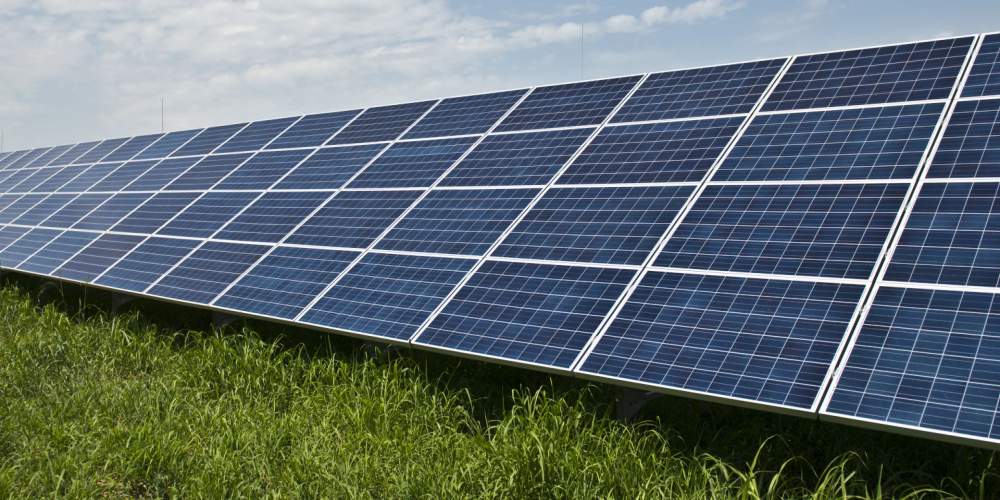
In a major milestone for the UK a 50MW solar farm has been directly connected to the electricity transmission network near Bristol. This will allow clean electricity generated at the site to be transmitted over greater distances around the UK. The solar farm will be able to generate 73GWh of electricity annually. This development heralds the beginning of the UK’s transition to a greener and more flexible electricity system dominated by renewable energy sources.
The renewable generator is owned and operated by developers Cero Generation and Enso Energy and co-located with a 50MW/99MWh battery energy storage system.
The 50MW Larks Green Solar farm is the first of its kind to feed electricity directly into the transmission network which is a significant step towards creating a secure, home-grown energy system for the UK and reaching its 2035 decarbonisation targets.
New switchgear was installed at the site by Cero and Enso in collaboration with the National Grid and a high voltage cable was run between the substation and the solar farm which enabled the National Grid to successfully connect the 50MW Larks Green solar farm to its Iron Acton substation near Bristol. The Larks Green project is comprised of 152,400 solar modules on a 200-acre site. This is the first time that a UK solar farm has connected to a higher voltage transmission rather than a local distribution network.
COMPARE PRICES FROM LOCAL INSTALLERS
Compare prices from local companies fast & free
Enter your postcode to compare quotes from leading professionals. We promise to keep your information Safe & Secure. Privacy Policy
Cero Generation is part of the portfolio of Australian financial services company Maquarie’s Green Investment Group (GIG), while Enso Energy is Cero’s UK development partner. According to the company, Cero Generation’s European portfolio includes “11GW under development, across 150 utility-scale and on-site generation projects”.
Marta Martinez Queimadelos, CEO of Cero Generation, said:
"As the country's first solar project to connect to the transmission network, it represents true innovation that paves the way for others to follow and enable the rapid deployment of much more clean energy."
It is anticipated that the solar farm will generate enough power each year to meet the needs of more than 17,300 average homes. The two companies have said that this will displace 20,000 tonnes of CO2 compared to that emitted by typical fossil fuel power sources.
The co-located battery storage system is a first for the solar specialist, Cero generation. Enso Energy explained that by storing electricity from peak times of solar generation on sunnier days and exporting it back to the grid when demand is high, the battery storage system will help balance intermittent energy production associated with renewables. The battery storage system will also maximise the site’s efficiency as well as allow a greater output of clean electricity.
Ian Harding, co-founder, and director of Enso Energy said:
“The connection of this solar farm at Larks Green is the culmination of a lot of hard work by all the Enso, Cero and National Grid teams involved. Completion of this project is a major milestone for renewable energy in the UK and provides further evidence that co-located solar and battery storage projects connecting directly to the transmission network will play an important role in the delivery of the UK's net zero plans."
The design and layout for the co-located solar farm has been designed to deliver “biodiversity net gain” which means that the site should add positively to the natural environment. The two companies say that this will be achieved through the provision of “a range of resources for local wildlife, including additional woodland planting, that will provide shelter and food for a range of protected species".
The Larks Green project is just one of 39 standalone or co-located renewable generators with battery storage being jointly developed by the two firms. Together they have a partnership pipeline which extends to 5GW with a further 5GW of early-stage opportunities.
Octopus Energy, a British renewable energy company specialising in sustainable energy, is calling for the government to push through reforms to help reduce the long queues of renewable projects waiting to be connected to the grid, in their latest report. As things stand the multi-year wait for grid connection in some cases could jeopardise the government's target of delivering a net zero emission grid by 2035.
Octopus Energy would like to see reforms that prioritised the most advanced projects for grid connections and shared data between developers and grid operators in order to speed up the process and allow for more clean energy capacity to be brought online.
The National Grid is working on upgrading, adapting, and maintaining its transmission network. It has spent around £5 billion since 2018 on its infrastructure and plans to spend £9 billion in the five years to 2026 with further multi-billion-pound investments beyond that to 2030. The National Grid is working towards delivering an affordable, resilient, and clean energy system as soon as possible. It is working with the Electricity System Operator (ESO) and industry to introduce a series of measures to help speed up connections to the electricity transmission network.
Roisin Quinn, Director of Customer Connections at National Grid, said:
“Solar power has a critical role to play in the clean energy transition, so connecting the first PV array to our high voltage transmission network represents a key step on that journey, and a great achievement by Cero, Enso and our engineering teams.”
Find a local installer
Welcome to the biggest directory of UK renewable energy companies





























